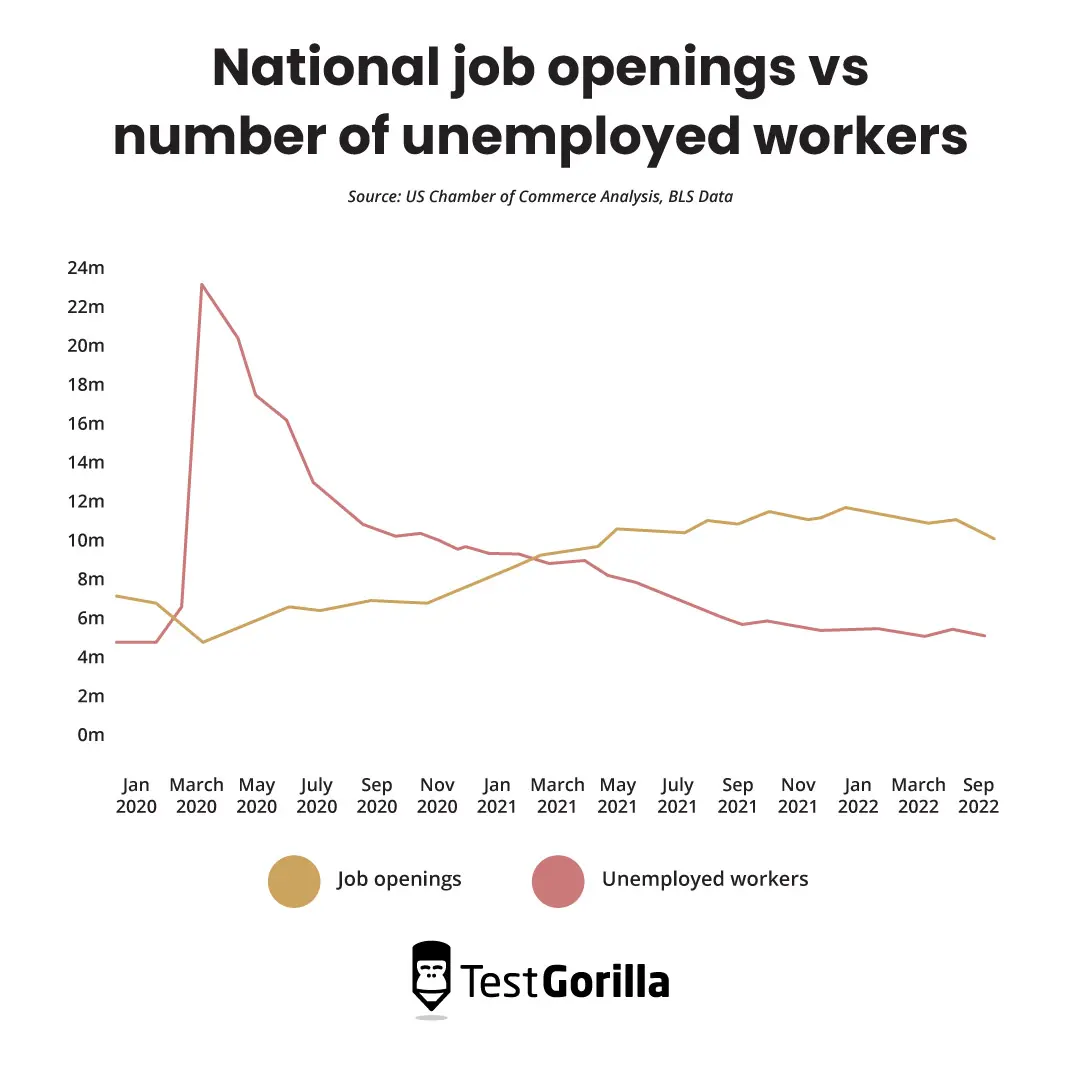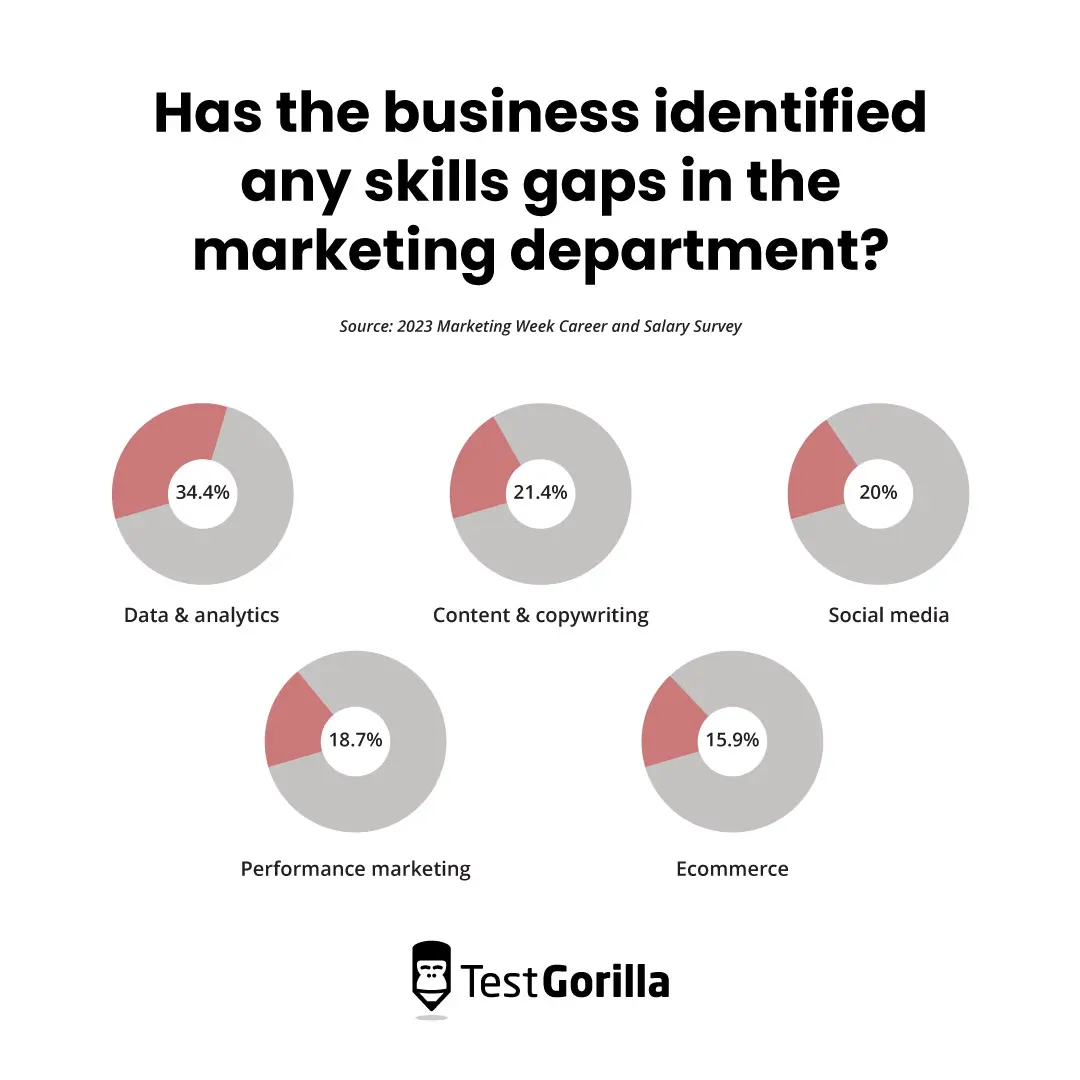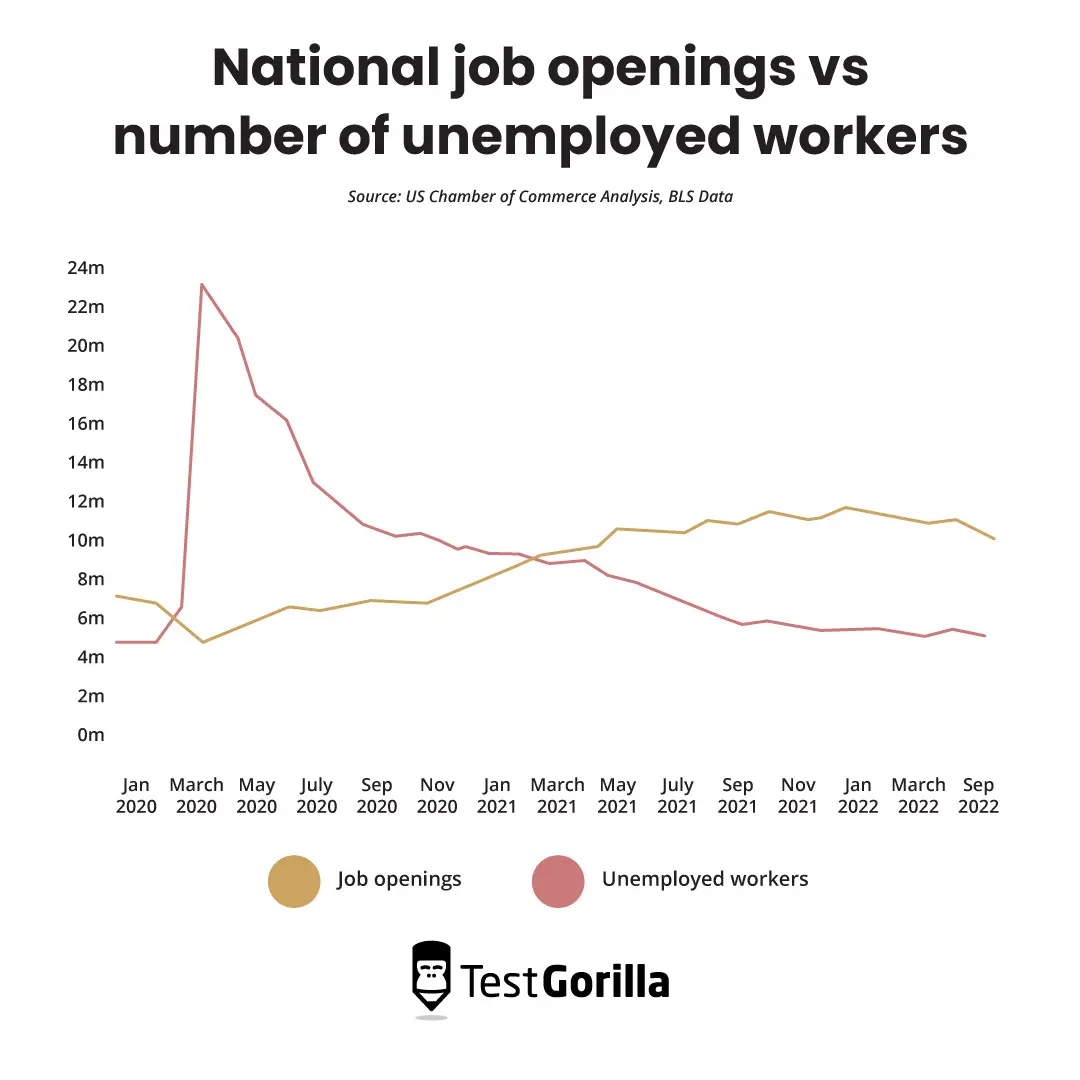Sometimes it feels like candidates are coming and going through a revolving door. You wait for ages for someone skilled to come along who can add to your company culture, then several arrive at once.
Next thing you know, everyone is gone, and you’re waiting on new talent once again.
These fluctuations aren’t in your head. Sometimes, there are more candidates than vacancies. But sometimes the balance flips, usually because of broader economic trends (say, world-halting pandemics).
Post-lockdown, many experts have declared a “candidate’s, or candidate-driven, market.”
Considering 2022 saw 75% of companies worldwide reporting talent shortages – the highest it’s been in 16 years – that claim seems pretty spot-on.[1] But is the balance tipping back in the employers’ favor in 2023?
Are we now in an employer’s market, or is it still a candidate’s one?
In this blog, we discuss the difference between a candidate’s market and an employer’s market and some best practices for hiring in different conditions.
Table of contents
What is a candidate’s market?
Put simply, a candidate’s market refers to when the number of open roles exceeds the number of qualified candidates available in the market.
In a candidate’s market, it may be harder for employers to fill open positions, and this gives candidates more bargaining power at the point of hiring.
A candidate’s market is usually caused by rapid changes in the skills that are required in the workplace, which causes skills shortages.
A skills shortage is a form of skills mismatch – when the need for a certain skill in a sector or region outstrips the number of candidates who have that skill. The difficulty in filling these roles often manifests in skills gaps within teams and companies.
| Skills gap | Skills shortage | Skills mismatch |
Definition | The lack of a required skill, whether in an individual or a team | When the demand for a skill set exceeds its supply in a specific region | An umbrella term referring to all problems related to the demand and supply of skills |
Example | A programmer not knowing a required programming language | The teacher shortage in the US | Skills gaps, skills shortages, overeducation, undereducation, overqualification, and underqualification |
Currently, skills shortages are most common in digital industries. For example, in the United States, a third of workers lack the digital skills needed to succeed in the current economy. This contributes to creating a candidate’s market for individuals who do have these skills.
Because employers don’t have as many options, skilled candidates have more bargaining power when negotiating their compensation and benefits, so they can usually demand a higher salary. One study found that leaders rated cybersecurity as the biggest skills gap of 2022, and a security engineer can command upwards of $120,000 per annum.[2] [3]
However, it’s also possible for a candidate’s market to apply more generally.
Salaries across the board have risen in the wake of the Great Resignation, increasing 4.5% in 2021 and a further 5.1% in 2022.[4]
Because of these factors, a candidate’s market brings with it particular disadvantages for employers.
For example, a candidate’s market might raise your turnover rate due to the number of choices that candidates have for work. The additional stress employee roles might incur when there are fewer skilled workers on their teams than there should be is also a contributor.
Additionally, employers are more likely to go over budget on recruiting due to increased competition for top candidates.
But what happens when the tables are turned?
What is a recruiter’s market?
A recruiter’s or employer’s market is the reverse of a candidate’s market: When the number of candidates exceeds the number of open positions.
This type of market hands power back to the employer, who can take their pick from a large pool of potential hires and negotiate salaries in a company’s favor.
A recruiter’s market usually occurs because of economic instability, with job losses raising the unemployment rate. For instance, the Great Recession of 2009 saw nearly 9 million workers lose their jobs, creating a major opportunity for recruiters.
There’s often binary thinking when it comes to the difference between a candidate’s market and a recruiter’s market.People tend to think that because a candidate’s market presents overt hiring challenges, a recruiter’s market is easy to hire in.
It’s true that an employer’s market has its benefits when businesses want to find candidates and negotiate salaries. However, it also has some distinct disadvantages.
One of the most significant challenges of an employer’s market is that with more choice, there also comes a bigger workload for hiring managers. It’s also more difficult to choose between candidates.
Additionally, the circumstances that cause an employer’s market can have negative effects on your staff.
For example, you may experience issues with employee well-being amid the economic downturn, with your employees having to support laid-off partners or living in fear of losing their jobs.
This issue can further intensify if you have to resort to layoffs. One study found that almost three-quarters (74%) of employees who kept their jobs after a round of layoffs reported a decline in productivity, while 87% of surviving workers said they were less likely to recommend their organization as an employer.
So, although keeping only some employees might be easier in a downturn, you may see diminished results due to stress. Not to mention a sudden surge of resignations once the economic situation stabilizes.
Clearly, each type of market has its advantages and disadvantages for employers and candidates – but which one are we in right now?
What kind of market are we in now?
To understand what kind of market we are currently operating in, we need to backtrack a few years to – you guessed it – the start of the Coronavirus pandemic.
The 2020-22 market
The shift to remote working wasn’t the only long-lasting change brought about by the lockdown. The Coronavirus pandemic also saw a sharp shift to an employer’s market.
Businesses were forced to shut down many of their consumer operations and tighten their belts, leaving thousands of workers out of a job.
Analysis by Pew Research revealed that unemployment rose higher in just three months of Covid-19 than it did in two years of the Great Recession.
The situation was a great example of why an employer’s market is not always a blessing: While employers who were hiring had their pick of candidates, many organizations were not in a position to benefit from this sudden switch.
This low rate of employment continued into 2021, with 8.5 million fewer people in jobs in February 2021 than in February 2020.
Of course, many organizations returned to business almost as usual much more quickly than expected. The US crossed back into a candidate’s market in March 2021, and candidates have more or less had the advantage in many sectors ever since.
This remains true even though the supply chain issues and economic fallout caused by Russia’s invasion of Ukraine have shaken many sectors across the globe.
So, where does this leave us going into 2023?
Will it remain a candidate’s market throughout 2023?
In 2023, we can expect the candidate’s market to continue around the world and across sectors, particularly when it comes to digital skills and service roles.
We can see this clearly in the United States, where the number of job openings had increased to 11 million by the end of 2022 whilst the overall number and rate of layoffs shifted only slightly, to 1.5 million and 1%, respectively. Layoffs and discharges even decreased in some sectors, including finance and insurance.
Meanwhile, in the UK, 13.3% of businesses reported a shortage of workers in November 2022, with the industries most affected being accommodation and food services at 35.5% and construction at 20.7%. Experts attribute the shortage to the ongoing after-effects of the pandemic, as well as the impact of Brexit on labor supply.
Many other industries are also suffering from shortages, most notably advertising and marketing.
Over half (56%) of brands felt that a skills shortage was stunting the industry’s growth in 2022, while 48% of companies believed the industry was facing its worst-ever talent crisis.
The situation is slightly more complicated when it comes to the tech sector.
There has long been a war for talent in tech, with 70% of companies experiencing a shortage of tech skills in 2022 alone.
The economic downturn and supply chain challenges posed by Russia’s invasion of Ukraine in 2022 have made things much worse, causing major disruptions among young tech companies throughout the UK and Europe.
Swedish “Buy now, pay later” giant Klarna had its valuation cut to $6.7bn (from the previous year’s high of over $46bn) in July 2022, and it wasn’t the only tech company to see belt-tightening.
This trend was echoed across tech startups when venture capital funding dipped to its lowest level in over a year in the second quarter, while tech job listings declined and layoffs rose.[5]
This is likely to continue into 2023; even the tech giant Amazon is expected to lay off as many as 20,000 workers.
Because of this, we’ll likely continue to see a candidate’s market when hiring for “hard skill” tech roles like software development and data analysis, even as tech companies are forced to jettison less “mission-critical” employees.
However, if 2020 has taught us anything, it’s that you never know what’s going to happen.
As comfortable as candidates have gotten running the market for the last year, we all know that it can switch quickly, so it’s worth preparing for both scenarios.
3 tips for hiring in a candidate’s market
To cope with hiring in the candidate’s market in 2023, you need to know the best practices for applying skills-based hiring in your organization.
Here are the top three that need to be on your radar. If you’re about to start a round of hiring and need answers fast, here’s a quick summary:
Best practice | Example actions |
Build your employer brand | Share content about your company culture on social media |
Create a positive candidate experience | Put salary range in your job ads, shorten your application forms, replace resumes with skills testing, communicate proactively with candidates |
Offer opportunities for upskilling | Give each employee their own personal development budget for skills training |
1. Build your employer brand
In a candidate’s market, you’re competing with many organizations to attract top talent. This is why employer branding is essentia –l because it helps you stand out amongst your competitors.
According to reports, a massive 60% of people say they would choose a workplace based on their beliefs and values. Meaning one of the most important things you can do is ensure that your company values are consistently visible.
A great example of this tactic is Google. The tech giant is known for being an innovative working environment that places emphasis on flexibility, creativity, and learning.
One of the main ways they broadcast this is through their “Life at Google” YouTube channel, where they post videos about their hiring process, the impact that individual “Googlers” make, and their “Ask A Googler” series.
Another way that you can build your employer brand is by creating a positive experience for candidates. Speaking of which…
2. Create a positive candidate experience
Nearly 60% of job seekers have suffered a poor candidate experience in the past. Creating a positive candidate experience, therefore, can put you on the map as an employer in a market where top candidates are able to pick and choose between opportunities.
It also helps you retain top talent once they’re hired by setting a precedent for respecting your employees and investing in their well-being.
Ways in which you can start improving your candidate experience right away include:
Putting the salary range in your job ads
Streamlining the application process by shortening application forms and replacing resumes with skills testing
Being proactive and respectful when it comes to delivering feedback to applicants – don’t make them chase you for feedback, especially after a rejection.
3. Offer opportunities for upskilling and reskilling
Another important way to stand out to candidates in a saturated employment market is by offering ample opportunities for upskilling and reskilling.
For example, at TestGorilla, we offer every employee a personal development budget of 3.5% of their annual salary. All they need to do is submit the development opportunities they want to pursue to their line manager for approval, and they can get paid time off to do the training they’ve chosen.
This helps candidates envision a long-term future at your organization by creating a clear path and mechanisms for advancement.
It also works in attracting new employees: 65% of workers say that employer-provided upskilling is a key factor when evaluating a new role.
Alongside bringing in top candidates, upskilling offers a clear incentive for employees to stay with your company long-term once they’re hired. It’s one of the best ways to reduce the turnover that a candidate’s market can cause.
3 tips for hiring in a recruiter’s market
An employer’s market gives you more choice and more leverage than a candidate’s market. But it also gives you more candidates to screen and a potentially harder job when it comes to choosing between the best ones.
How can you hire the best candidates in an employer’s market while also mitigating the disadvantages that come with it?
If you’re short on time and already fielding a large number of potential candidates, here’s a quick breakdown of our tips.
Best practice | Example actions |
Use skills testing to screen applicants | Stop asking candidates for resumes |
| Use skills testing to assess key skills areas for the role at hand |
Take a structured approach to interviews | Ask all candidates the same questions in the same order, determine criteria for what makes a “good” answer with stakeholders ahead of time, use numerical scoring for each answer to compare candidates’ performance |
Support employees with well-being initiatives | Invest in a health insurance plan that covers mental health support for times of stress, pay for employees to receive finance or debt management coaching |
1. Use skills testing to screen applicants
With potentially hundreds of applicants applying to each open role, speed and accuracy are the name of the game in an employer’s market. The best and most effective way to reduce time spent without reducing the quality of your hires is to use skills testing.
Skills testing is a more efficient alternative to resume evaluation because rather than burying yourself alive under a pile of resumes – all of which follow different formats, contain different information, and potentially even lies – you can simply test candidates’ skills directly.
Google found that skills testing was over twice as effective as unstructured interviews in predicting job performance, followed by structured interviews (which we’ll cover in a moment).[6]
In our own State of Skills Based Hiring report for 2022, we found that after switching to skills-based hiring techniques:
89.8% of organizations saw a reduction in cost-to-hire
91.4% of organizations saw a reduction in time-to-hire
92.5% of organizations saw a reduction in mis-hires
2. Take a structured approach to interviewing candidates
Another way of improving your efficiency without reducing your accuracy when hiring is to use a structured interview technique. Unlike the traditional unstructured interview, structured interviews require that hiring managers ask candidates:
The same questions (usually behavioral or situational judgment questions)
In the same order
Using the same criteria, agreed with stakeholders beforehand, to determine a “good” answer
Although structured interviews do require pre-planning ahead of the actual interviews, they drastically reduce the time spent um-ing and ahh-ing over candidates afterward by giving you the ability to compare them effectively.
No more working out which candidate is better for the role based on two completely different interviews!
Many interviewers even score a candidate’s answers out of 10 to further drive data-driven decision-making.
Structured interviews also have the advantage of reducing bias by ensuring that you ask every candidate about the core competencies of the role.
3. Support employees holistically with well-being initiatives
Finally, you can alleviate the outside stresses that may be impacting your employees’ focus in a recruiter’s market using well-crafted employee well-being initiatives.
We’re not talking about a “bring your dog to work day” or putting out a fruit bowl that everyone ignores – we want real, impactful initiatives here.
For instance, you might invest in a health insurance plan that includes counseling sessions for those suffering from stress due to an economic downturn. Alternatively, you could pay for employees to receive investment or debt management coaching to relieve their financial concerns.
As well as boosting morale, these initiatives are also likely to protect your organization from the damaging effects of the economic circumstances that contribute to an employer’s market, like a loss of productivity due to layoffs.
A Glassdoor study found that each one-star improvement in a company’s rating by employees corresponds to a 1.3-point out of 100 improvement in customer satisfaction scores.
Use skills-based hiring to the best, no matter the market
Do you want to know the best news?
All of the best practices we’ve described above can be applied as part of a skills-based hiring approach and will make a positive impact regardless of whether you’re in a candidate’s market or a recruiter’s one.
By employing these strategies, you can hire top talent in the ongoing candidate’s market in 2023 and in whatever conditions are thrown at you in 2024 and beyond.
If you’re ready to brave the candidate’s market to find your next great hire, conduct a skills gap analysis to focus your hiring efforts, or, if you’ve already got a role in mind, use our online Motivation test to identify the candidate whose vision best aligns with yours.
Sources
“The Talent Shortage”. (2022). ManPowerGroup. Retrieved March 03, 2023. https://go.manpowergroup.com/talent-shortage
“State of Upskilling Report 2022”. (2022). PluralSight. Retrieved March 03, 2023. https://www.pluralsight.com/resource-center/state-of-upskilling-2022
“Cyber Security average salary in the USA, 2023”. Talent.com. Retrieved March 03, 2023. https://www.talent.com/salary?job=cyber+security
“Employment Cost Index – December 2022”. (December 2022). Bureau of Labor Statistics. Retrieved March 03, 2023. https://www.bls.gov/news.release/pdf/eci.pdf
Nugent, Tom. “Are we in a downturn? What the data tells us about European tech in 2022”. (August 8, 2022). Sifted. Retrieved March 03, 2023. https://sifted.eu/articles/tech-downturn-european-startups-2022-h1/
Bock, Laszlo. (April 2015). “Here’s Google’s Secret to Hiring the Best People”. WIRED. Retrieved March 03, 2023. https://www.wired.com/2015/04/hire-like-google
Related posts
Hire the best candidates with TestGorilla
Create pre-employment assessments in minutes to screen candidates, save time, and hire the best talent.
Latest posts
The best advice in pre-employment testing, in your inbox.
No spam. Unsubscribe at any time.

Hire the best. No bias. No stress.
Our screening tests identify the best candidates and make your hiring decisions faster, easier, and bias-free.
Free resources
This checklist covers key features you should look for when choosing a skills testing platform
This resource will help you develop an onboarding checklist for new hires.
How to assess your candidates' attention to detail.
Learn how to get human resources certified through HRCI or SHRM.
Learn how you can improve the level of talent at your company.
Learn how CapitalT reduced hiring bias with online skills assessments.
Learn how to make the resume process more efficient and more effective.
Improve your hiring strategy with these 7 critical recruitment metrics.
Learn how Sukhi decreased time spent reviewing resumes by 83%!
Hire more efficiently with these hacks that 99% of recruiters aren't using.
Make a business case for diversity and inclusion initiatives with this data.






















